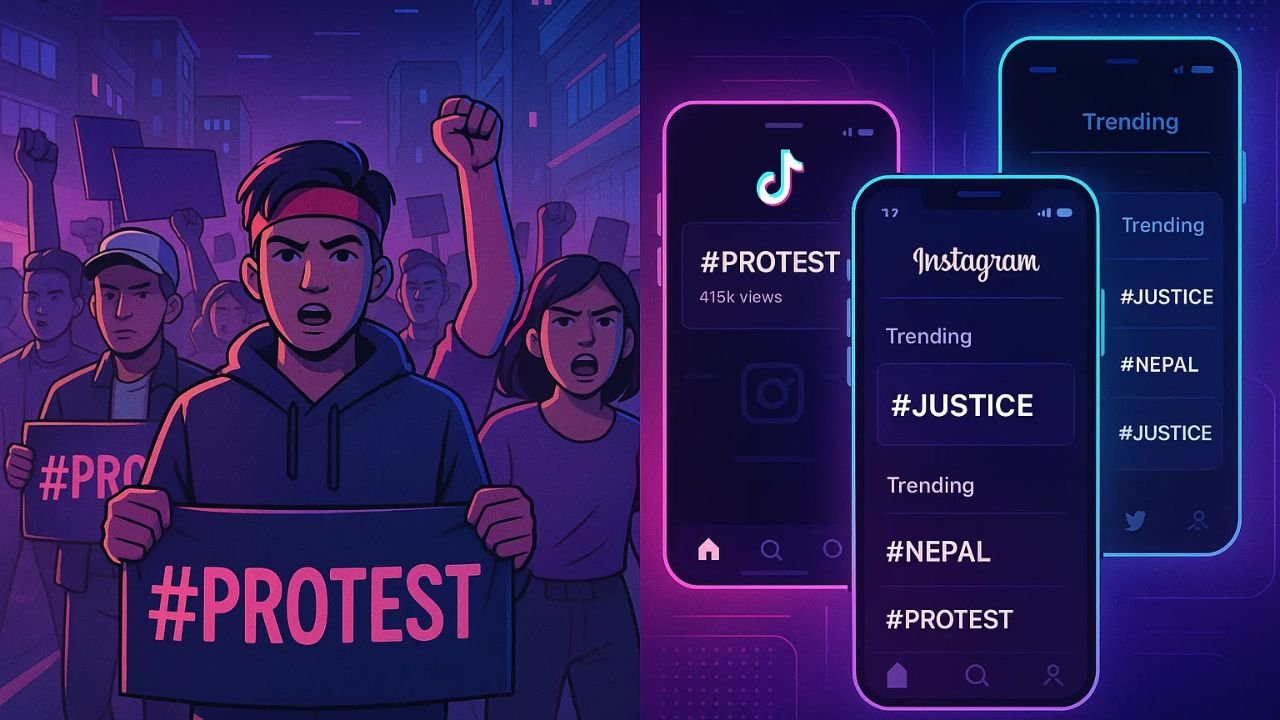Fueling Gen Z Youth Movements
Table of Contents
Introduction
In recent years, Nepal has witnessed a surge of youth led protests, with Gen Z at the forefront. What sets these movements apart from the past is not just their passion but the powerful tool they carry in their pockets: social media in Nepal. Platforms like TikTok, Instagram, and X (formerly Twitter) have transformed how young Nepalis organize, spread awareness, and demand change. This digital shift is not only reshaping politics but also redefining what activism looks like in the country.
The Rise of Social Media in Nepal
The last decade has been revolutionary for social media in Nepal. Affordable smartphones and wider internet access mean that even in remote towns, young people are scrolling, posting, and connecting. According to reports, millions of Nepalis most under 30 are active on platforms like Facebook, TikTok, and Instagram daily. For Gen Z, these platforms are more than entertainment; they are gateways to information and activism.
Why Gen Z Turns to Social Media
Traditional political spaces in Nepal have often been dominated by older generations. Frustrated by corruption, unemployment, and lack of opportunities, Gen Z needed a louder voice. Social media in Nepal gave them exactly that. Instead of waiting for TV news or newspapers to cover their concerns, young activists now livestream protests, create trending hashtags, and call out leaders in real time.
TikTok and Instagram: The Protest Playground
Among all platforms, TikTok and Instagram are the most influential for social media in Nepal. Protesters create short videos showing large gatherings, emotional speeches, and moments of solidarity. These clips go viral within hours, motivating others to join. Instagram stories and reels also serve as digital posters, spreading protest dates, slogans, and demands across the country.
X (Twitter) and the Power of Hashtags
X (Twitter) plays a unique role in social media in Nepal. Hashtags created during protests often trend nationally, making it impossible for the government and media to ignore the issues. A hashtag campaign like #NepalYouthRise or #GenZProtests can gain momentum overnight, drawing global attention to local struggles.

Organizing Without Borders
One of the strongest features of social media in Nepal is its ability to break barriers. Youth from Kathmandu can instantly connect with those in Pokhara, Biratnagar, or even the Nepali diaspora abroad. This borderless connection builds solidarity and helps in organizing nationwide demonstrations. Many Nepali students studying abroad also contribute by amplifying protest content on global platforms.
The Digital Risks Protesters Face
While social media in Nepal empowers young activists, it also exposes them to risks. The government has occasionally tried to restrict internet access or monitor online conversations. Protesters face threats of cyber-bullying, online surveillance, or even arrests for their posts. Despite these risks, Gen Z continues to use digital tools fearlessly, proving that their voice cannot be silenced easily.
How Social Media Shapes Public Opinion
The influence of social media in Nepal goes beyond protests. It shapes how the public views politicians, policies, and social issues. A viral post can build sympathy for protesters or expose government failures within hours. This rapid spread of information forces mainstream media to cover stories they might otherwise ignore.
Comparing with Other Countries
Nepal is not alone in this trend. Around the world, young people are turning to digital platforms for activism. From climate strikes in Europe to pro-democracy movements in Asia, social media in Nepal mirrors a global shift. What makes Nepal unique is the scale of youth involvement compared to its population. In a country where over 40% are under 25, the digital voice of Gen Z carries enormous weight.
Beyond Protests: A Tool for Social Change
Social media in Nepal is not only about protests. Young activists also use it to promote education, mental health awareness, gender equality, and environmental issues. Campaigns for women’s rights or climate action often start as hashtags but turn into real-world initiatives. This shows that digital activism is more than short lived outrage; it can spark lasting change.
The Future of Youth Activism in Nepal
The story of social media in Nepal is still unfolding. As technology advances, platforms will become even more powerful in shaping political and social landscapes. Gen Z is unlikely to give up their digital voice; instead, they will refine it. The challenge will be balancing activism with safety, and ensuring that online energy translates into real policy changes.
Conclusion
From TikTok reels to trending hashtags, social media in Nepal has become the heartbeat of Gen Z activism. It connects, inspires, and empowers young people who are determined to build a better future. While risks remain, the digital revolution has already changed the way protests and movements take shape in Nepal. If the past few years are any indication, the next wave of social change will not only be seen on the streets of Kathmandu but also on the screens of millions of young Nepalis.
Related Reading
📌 Gen Z Protests in Nepal: A New Wave of Youth Activism
BBC: Nepal lifts social media ban after 19 killed in protests
